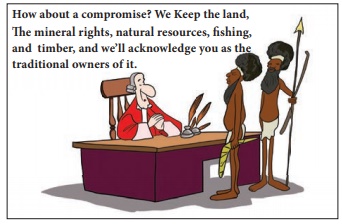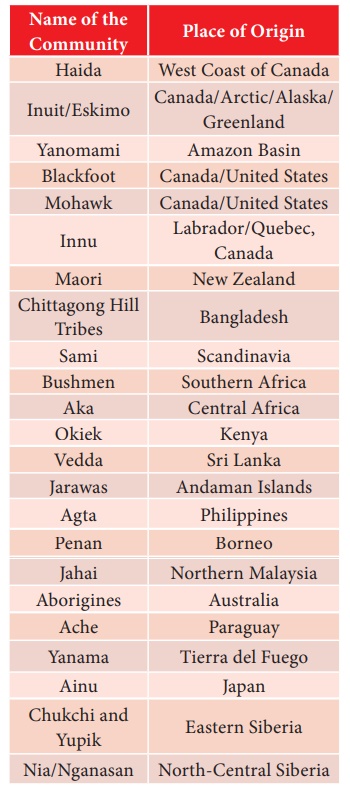Environmental Concerns and Globalisation - Indigenous People and their Rights | 12th Political Science : Chapter 12 : Environmental Concerns and Globalisation
Chapter: 12th Political Science : Chapter 12 : Environmental Concerns and Globalisation
Indigenous People and their Rights
Indigenous People and their Rights
Definition
In a popular sense, the very meaning of cultural
diversity is often represented by indigenous peoples. Approximately 350 million
indigenous peoples belonging to 5000 different cultures are residing over 20
percent of the EarthŌĆÖs territory. Of all the challenges concerning the realm of
indigenous people and their rights, the most arduous has been the inability to reach
a consensus on who are indigenous peoples. Hence, the dilemma centres on the
fundamental question vis-├Ā-vis the factors that converge in building what
indigeneity means. Even the UN Working Group on the Rights of Indigenous
Peoples could not arrive at a formal definition that explains the true identity
of theirs. The primary dilemma that made this process a rigmarole was the
inconclusiveness on working out a set of absolute parameters that assign
indigeneity to a group
Self-Identification
There is no international agreement
on the definition of indigenous peoples. Indigenous communities decide their
case of indigeneity. It is called ŌĆ£Self-IdentificationŌĆØ.
Is it the smallness in the population that matters?
Or is it the proximity to oneŌĆÖs own land, and the corresponding longevity, and
a conventional non-industrial lifestyle that make up the indigenous identity?
An element of uniformity was achieved on defining certain groups such as the
First Nation/Native American of North America, the residents of the Amazon
jungles, Inuit from the far North and the indigenous groups based in Papua New
Guinea. Out of the multiple attempts in search of a universally recognized
definition, the one by Julian Berger, a UN official, stands important.
According to him, ŌĆ£the notion of belonging to a separate culture with all its
various elements ŌĆō language, religion, social, political systems, moral values,
scientific and philosophical knowledge, beliefs, legends, laws, economic
systems, technology, art, clothing, music, dance, architecture, and so on ŌĆō is
central to indigenous peopleŌĆÖs own definitionŌĆØ. He further states, indigenous
peoples

1) Are the descendants of the original habitants of
a territory which has been overcome by conquest;
2) Are nomadic and semi-nomadic peoples, such as
shifting cultivators, herders and hunters and gatherers, and practice a
labour-intensive form of agriculture which produces little surplus and has low
energy needs;
3) Do not have centralized political institutions
and organize at the level of the community and make decisions on a consensus
basis;
4) Have all the characteristics of a national
minority: they share a common language, religion, culture, and other
identifying characteristics and a relationship to a particular territory but
are subjugated by a dominant culture and society;
5) Have a different world view, consisting of a
custodial and non-materialist attitude to land and natural resources, and want to
pursue a separate development to that proffered by the dominant society;
6) Consist of individuals who subjectively consider
themselves to be indigenous, and are accepted by the group as such.
The contemporary understanding is that the indigenous
peoples, in general, are marked by deficits in authority and political power,
and the corresponding absence of inclusion. Their existence is also characterized
by subordination to an immigrant or ethnic group-dominant state. It is
important to note that their indigeneity is not a product of the lack of power.
Rather, the powerlessness emanates from their indigeneity. These groups, with
their inherent and inviolable constancy to the conventional way of life-based
on the endemic values and traditions, kept them aloof from the evolution that
helped advance the social, political and economic establishments. In turn, the
indigenous peoples were looked upon as a threat to this ŌĆ£march of progressŌĆØ and
the changing order of life. It is also important to know that the indigenous
populations are not essentially ŌĆ£socially-staticŌĆØ or status-quoists. The global
tendency to accuse them as conservative is a result of their slow pace of
response to the assimilation and adaptation against the increasing complexity
of the macro-social systems.
World Indigenous People Day
International Day of the WorldŌĆÖs
Indigenous People is celebrated on 9th August every year.
LetŌĆÖs have a look at some of the most important indigenous societies in the world:

Building an Indian conceptual case of indigeneity
receives both theoretical and empirical setbacks. Officially, the Government of
India hardly recognizes any community in the country as indigenous. However,
experts are of the view that there are three assumptions that help construct an
Indian approach towards the puzzle of indigenous identity. They are: a)
Indigenous are those groups of people who have lived in a region or country to which
they belong before colonization or conquest by people from outside that region
or country. b) They have become marginalized as a result of colonization or
conquest of that region or country. c) Such groups are governed more by means
of their own social, economic and cultural institutions rather than the laws
which are applicable to the society or country as a whole. Besides, the concept
of indigeneity in India is a product of the prevailing ŌĆ£tribal consciousnessŌĆØ.
The idea of tribal identity has more often than not guided the national debates
on what constitutes indigenous populace in India.
The indigenous groups in India have been referred
under multiple titles. Adivasis (original inhabitants), Aborigines, Adim Jati
(ancient tribes) or Vanavasi (forest dwellers). Under the constitution, they
are recognized as ŌĆ£Scheduled TribesŌĆØ and their territories as ŌĆ£Scheduled
AreasŌĆØ. In spite of the absence of a formal definition by the Government of
India, a loose definition in terms of reaching a legal consensus was
constructed by bringing a set of features like ŌĆ£ŌĆśprimitiveŌĆÖ traits, distinctive
culture, geographical isolation, shyness of contact with the community at large
and backwardnessŌĆØ. Groups with a demographic base of millions such as Gondas
and Bhils to the Great Andamanese, who are of around just dozens in strength,
come under this category. Furthermore, Sharad Kulkarni, in his work ŌĆ£India:
Indigenous communities in the sub-continentŌĆØ (1988), says:
ŌĆ£The indigenous tribal peoples of India have lost
most of their tranquil habitats; they have also lost some of their confidence
and identity. Forces of oppression and exploitation have encroached upon tribal
life and have reduced many of them to sub-human conditions. The laws meant for
their protection have remained largely ineffective. However, efforts made some
impact in raising their standard of living. Social activists have contributed to
mobilizing them for the protection of their rights. The picture is rather
gloomy and unclear but there are rays of hope on the horizonŌĆØ.
Threats and Issues faced by Indigenous People
┬Ę
Discrimination and structural
violence
┬Ę
Eviction from homeland resulting in
the denial of land rights
┬Ę
Technology-driven forced resettlement
┬Ę
Exploitation of intellectual property
such as traditional arts, stories etc.
┬Ę
Physical removal from native
territories
┬Ę
Lack of access to traditional
resources
┬Ę
Destructive development and forced
displacement
┬Ę
Question of Autonomy and
Self-Determination
┬Ę
Neglect by civil society
┬Ę
Only a few countries recognize
indigenous peoples as legitimate groups
┬Ę
Minimal political participation
┬Ę
Poverty
┬Ę
Health issues
┬Ę
Unemployment
It is noteworthy that the Indian stance of
indigeneity also coincides with the global strides of anticolonial imperatives
supported by the canons of subaltern inputs. In addition, the concept of
indigeneity in India more or less overlaps with what can be called ŌĆ£tribal
consciousnessŌĆØ. Globally, the indigenous groups are subjected to a great deal
of challenges. By virtue of their identity, they are often mistreated as
second-class citizens by the so called ŌĆ£mainstreamŌĆØ citizens. The major
challenges faced by the indigenous peoples are as follows:
Rights of the Indigenous People
The United Nations Declaration on the Rights of
Indigenous Peoples (UNDRIP) was adopted on 13 September 2007 by the UN General
Assembly. As the most comprehensive international instrument on the indigenous
peoplesŌĆÖ rights, it seeks to ensure a ŌĆ£universal framework of minimum standards
for the survival,dignityandwell-beingoftheindigenous peoples of the worldsŌĆØ.
The Declaration contains 46 Articles which is the outcome of a drafting process
which began in 1985 by the Working Group on Indigenous Populations. In its
essence, the UNDRIP is a manual for the governments of the world on how to revere
the human rights of the indigenous communities. It also serves in helping the
enforcement of other mechanisms, affecting indigenous groups, like the
Convention on the Rights of the Child, ILo Convention 169, and the Convention
on the Elimination of All Forms of Discrimination against Women
Human Rights, Self-Determination and Nationality
Articles 1 ŌĆō 6
o Right to all human rights
o Right to freedom and equality and right against
exploitation
o Right to self-determination
o Right to autonomy or self-government
o Right to maintain their distinct political,
legal, economic, social and cultural identity
o Right to nationality
Life, Liberty, Culture and Security
Articles 7 ŌĆō 10
o Right to life, liberty and security
o Right against forced assimilation or destruction
of culture
o Right to belong to an indigenous community or a
nation
o Right against forced removal or relocation
Culture, Religion and Language
Articles 11-13
o Right to culture
o Right to spiritual and religious traditions and
customs
o Right to know and use language, histories and
oral traditions
Education, Media and Employment
Articles 14-17
o Right to establish educational systems and access
to culturally sensitive education
o Right to accurate reflection of indigenous
cultures in education
o Right to create media in their own language and
access to non-indigenous media
o Right to employment
Participation and Development
Articles 18-24
o Right to participation in decision making
o Right of free, prior and informed consent for
laws and policies
o Right to their own political, economic and social
system, subsistence and development
o Right to economic and social well-being
o Right against violence and discrimination of
indigenous elders, women, youth, children and persons with disabilities
o Right to set priorities and strategies for
development
o Right to health
Land and Resources
Articles 25-32
o Right to spiritual relationship with traditional
land and resources
o Right to own, use, develop and control
traditional land and resources
o Right to indigenous laws and traditions on land
and resources
o Right to get back or to be compensated against
the land acquisitions without their free, prior and informed consent
o Right against militarization on indigenous land
without their free, prior and informed consent
o Right to cultural and intellectual property
o Right to decide on land and resource development
Self-Government and Indigenous Laws
Articles 33-37
o Right to identity, membership and citizenship
o Right to distinctive institutional structures and
customs
o Right to individual responsibilities
o Right to maintain and develop contacts, relations
and cooperation
o Right to recognition, observance and enforcement
of treaties and agreements
Implementation
Articles 38-42
o Right to be consulted by the states in taking
measures to achieve the ends of the Declaration
o Right to financial and technical assistance from
States for the enjoyment of the rights contained in the Declaration
o Right to just and fair procedures for the
conflicts and disputes with States or other parties
o The responsibility on the UN system and other
intergovernmental agencies to contribute towards realization of the provisions
of the Declaration.
o The responsibility of the UN, its bodies,
including to Permanent Forum on Indigenous Issues, to promote respect for and
full application of the provisions of the Declaration.
Nature of Guarantee
Articles 43-44
o The rights as enshrined are considered the
minimum standards for the survival, dignity and well-being of the indigenous
people.
o Equal guarantee of all rights to male and female indigenous individuals.
Activity
Identify the
indigenous peoples based in the state of Tamil Nadu.
Related Topics